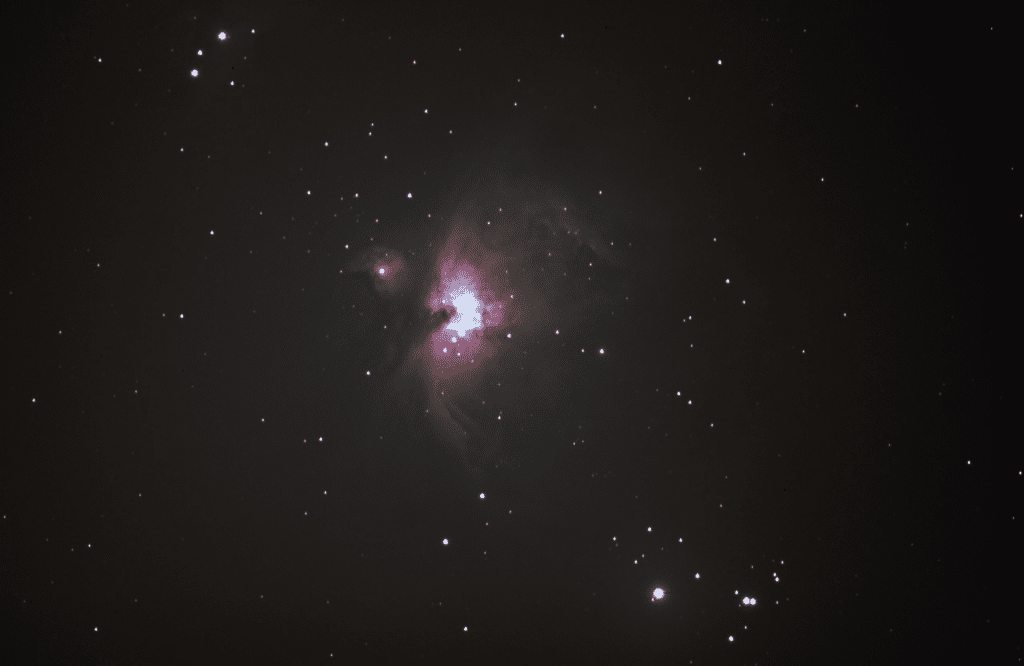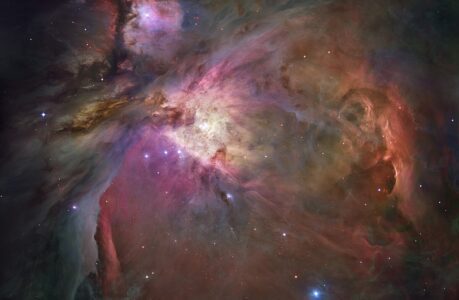Unveiling the Mysteries of the Orion Nebula
The Orion Nebula, also known as Messier 42 or NGC 1976, stands as one of the most captivating celestial phenomena in our night sky. Situated in the Orion constellation, this cosmic spectacle has long captured the imagination of astronomers and stargazers alike. Let’s delve into the depths of this stellar marvel, exploring its intricacies, mysteries, and significance.
A Celestial Marvel in the Night Sky
When you gaze upon the night sky, particularly during the winter months, one celestial wonder often steals the show: the Orion Nebula. Located approximately 1,344 light-years away from Earth, this stellar nursery dazzles observers with its ethereal beauty and cosmic significance. Visible to the naked eye as a faint smudge in the sword of the Orion constellation, the nebula becomes even more awe-inspiring when viewed through telescopes or binoculars.
The Orion Nebula is not only a captivating sight but also a celestial laboratory, offering astronomers a unique opportunity to study the process of star formation in unprecedented detail. Its proximity to Earth and relatively young age make it an ideal target for observation and research. By analyzing the structure, composition, and dynamics of the nebula, scientists can gain valuable insights into the mechanisms that govern the birth and evolution of stars.
Understanding Nebulae
Nebulae are immense clouds of gas and dust scattered throughout the cosmos, serving as the birthplaces of stars and the remnants of stellar explosions. These cosmic structures come in various shapes, sizes, and compositions, each offering unique insights into the processes shaping our universe.
Nebulae are primarily composed of hydrogen and helium, along with traces of other elements such as oxygen, carbon, and nitrogen. They can be classified into several categories based on their origins, compositions, and appearances.
The Orion Nebula: A Stellar Nursery
The Orion Nebula belongs to the category of emission nebulae, characterized by their vibrant glow resulting from the ionization of surrounding gases by nearby stars. These nebulae typically emit light across a broad range of wavelengths, giving them their distinctive colors.
Located within the Orion constellation, the Orion Nebula is a stellar nursery—a vast region where new stars are born. It is primarily composed of hydrogen gas, which becomes ionized by the intense ultraviolet radiation emitted by young, hot stars nestled within its midst. As these stars undergo nuclear fusion, they emit copious amounts of energy, illuminating the surrounding gas clouds and giving rise to the nebula’s luminous glow.
The Orion Nebula’s intricate structure and dynamic nature make it a fascinating subject of study for astronomers. Within its sprawling expanse, dense pockets of gas and dust known as protostellar cores serve as incubators for young stars. These cores undergo gravitational collapse, eventually igniting nuclear fusion and heralding the birth of new stellar bodies.
Unraveling the Birthplace of Stars
At the heart of the Orion Nebula lies a stellar nursery—a vast region where new stars are born. Deep within its luminous clouds of gas and dust, the process of stellar birth unfolds in spectacular fashion. Dense pockets within the nebula, known as protostellar cores, serve as incubators for young stars. As these cores collapse under their own gravity, they ignite nuclear fusion, marking the birth of new stellar bodies. The Orion Nebula thus offers a glimpse into the cosmic cradle of star formation, shedding light on the origins of celestial bodies that populate our galaxy.
The birth of stars within the Orion Nebula is a complex and dynamic process, driven by the interplay of gravity, pressure, and magnetic fields. As protostellar cores collapse and accrete matter from their surrounding environment, they undergo dramatic changes, evolving into fully-fledged stars over millions of years. Some of these newborn stars emit powerful jets of gas and radiation, sculpting the surrounding nebula and shaping its intricate structure.
A Stellar Spectacle of Cosmic Proportions
The Orion Nebula spans an impressive 24 light-years across, making it one of the largest and brightest nebulae visible from Earth. Its radiant glow emanates from the intense ultraviolet radiation emitted by young, hot stars nestled within its midst. The nebula’s distinctive hues of red, blue, and green are a testament to the diverse array of gases present, including hydrogen, helium, and ionized oxygen. These vibrant colors paint a mesmerizing tableau against the backdrop of the dark interstellar void, captivating observers and astronomers alike.
The striking beauty of the Orion Nebula is not merely aesthetic; it also serves as a valuable tool for scientists seeking to unravel the mysteries of the cosmos. By studying its luminous emissions and spectral signatures, astronomers can glean valuable information about the physical properties of its constituent gases and the processes that drive their evolution. This data provides crucial insights into the formation and evolution of nebulae, as well as the lifecycle of stars within them.
Age and Formation of the Orion Nebula
The Orion Nebula, located approximately 1,344 light-years away from Earth, is estimated to be relatively young in astronomical terms, with an age of around 2 million years. Despite its youth, this stellar nursery has already played a significant role in the formation of new stars and planetary systems within its expansive confines.
The formation of the Orion Nebula can be traced back to a complex series of events within the Orion Molecular Cloud Complex, a vast region of interstellar gas and dust located in the Orion constellation. Over millions of years, gravitational forces acting on the dense pockets of gas and dust within this molecular cloud triggered the collapse of protostellar cores, giving rise to the birth of new stars.
As these protostellar cores collapsed under their own gravity, they accreted surrounding gas and dust, gradually building up mass and density. Eventually, the pressure and temperature at the core of these collapsing clouds reached a critical threshold, triggering nuclear fusion—a process that marks the birth of a star.
The intense radiation emitted by these newly formed stars ionized the surrounding hydrogen gas, creating the characteristic glow of the Orion Nebula. Over time, the combined effects of stellar winds, radiation pressure, and gravitational interactions sculpted the nebula’s intricate structure, giving rise to its awe-inspiring beauty.
Gateway to Stellar Evolution
Beyond its aesthetic appeal, the Orion Nebula serves as a natural laboratory for studying stellar evolution and the dynamics of interstellar gas clouds. Astronomers scrutinize its intricate structure and dynamics to better understand the processes that govern star formation and the lifecycle of stellar systems. By analyzing the properties of young stars within the nebula and the surrounding gas clouds, scientists can glean insights into the factors influencing the formation of planetary systems, including our own solar system.
The study of stellar evolution within the Orion Nebula has yielded groundbreaking discoveries and revolutionized our understanding of the cosmos. By observing the birth and evolution of stars in real-time, astronomers can test theoretical models of star formation and refine our understanding of the underlying physical processes. This research not only sheds light on the origins of stars and planets but also offers valuable insights into the broader context of galactic and cosmic evolution.
A Cosmic Time Capsule
In addition to its role as a stellar nursery, the Orion Nebula offers a glimpse into the past, providing astronomers with a window into the early stages of our universe’s evolution. The light that reaches us from the nebula has traveled for over a millennium, carrying with it clues about the conditions prevailing in the cosmos millennia ago. By studying the spectral signatures of elements within the nebula and the radiation emitted by its stars, scientists can piece together a timeline of cosmic events, unraveling the mysteries of our universe’s origins.
The study of ancient light from the Orion Nebula allows astronomers to peer back in time and witness key milestones in the history of the cosmos. By analyzing the composition and structure of the nebula, researchers can reconstruct the environmental conditions present during its formation and infer the processes that shaped its evolution over billions of years. This archaeological approach to astronomy provides valuable insights into the early universe and the conditions that gave rise to the galaxies, stars, and planets we observe today.
Viewing the Orion Nebula from Ireland
As an astronomy enthusiast in Ireland, witnessing the splendor of the Orion Nebula is an exciting endeavor that requires a clear night sky and a basic understanding of celestial navigation. Be aware that the Orion Nebula will look relatively small in the Night sky, so you’re looking for something that looks more like the following:

Here’s how you can locate and view the Orion Nebula from Ireland:
1. Find a Dark Sky Location
Choose a location away from city lights to minimize light pollution, ideally in rural areas or designated dark sky sites. Places such as rural countryside or remote coastal areas offer optimal conditions for stargazing.
2. Know the Best Time to View
The Orion Nebula is most easily visible during the winter months in the Northern Hemisphere, typically from late autumn to early spring. Look for clear, moonless nights for the best viewing conditions.
3. Locate the Orion Constellation
The Orion Nebula is situated within the Orion constellation, which is easily recognizable due to its distinctive “belt” of three bright stars. Look for Orion rising in the eastern sky during the evening hours.

4. Identify the Sword of Orion
Within the Orion constellation, locate the “sword” hanging from Orion’s belt. The Orion Nebula is found within this region, appearing as a faint smudge to the naked eye.
5. Use Binoculars or a Telescope
While the Orion Nebula is visible to the naked eye under dark sky conditions, using binoculars or a telescope will enhance your viewing experience and reveal more detail. Point your optical instrument towards the location of the nebula within the Orion constellation.
6. Allow Your Eyes to Adapt
Give your eyes time to adjust to the darkness to improve your ability to see faint celestial objects like the Orion Nebula. Avoid looking at bright lights or electronic devices for several minutes before stargazing.
7. Be Patient and Observant
Take your time to scan the sky and allow your eyes to adjust to different levels of brightness. Look for the distinctive glow of the Orion Nebula amidst the surrounding stars and nebulous regions.
8. Capture the Moment
Consider bringing a camera with manual settings to capture long-exposure photographs of the Orion Nebula and other celestial objects. Experiment with different exposure times and settings to achieve the best results.
By following these steps and taking advantage of clear nights, dark sky locations, and optical aids like binoculars or telescopes, you can enjoy the breathtaking sight of the Orion Nebula from Ireland. Remember to dress warmly, bring along any necessary equipment, and embrace the wonder of the cosmos unfolding above you.
Journey into the Orion Nebula
Embark on a virtual journey into the heart of the Orion Nebula with these stunning images captured by NASA’s Hubble Space Telescope. Witness the intricate details of this celestial marvel and marvel at the cosmic forces at play.
- HubbleSite: Orion Nebula
- NASA: Orion Nebula
- ESA: Stunning Views of the Orion Nebula
- Space.com: Orion Nebula Facts
Exploring the Cosmic Tapestry
As we peer into the depths of the Orion Nebula, we are reminded of the vastness and beauty of the cosmos. From its role as a stellar nursery to its significance in unraveling the mysteries of stellar evolution, this celestial masterpiece continues to captivate and inspire generations of astronomers and stargazers. As we continue to explore the universe, the Orion Nebula stands as a shining beacon, beckoning us to delve deeper into the cosmic tapestry that surrounds us.

